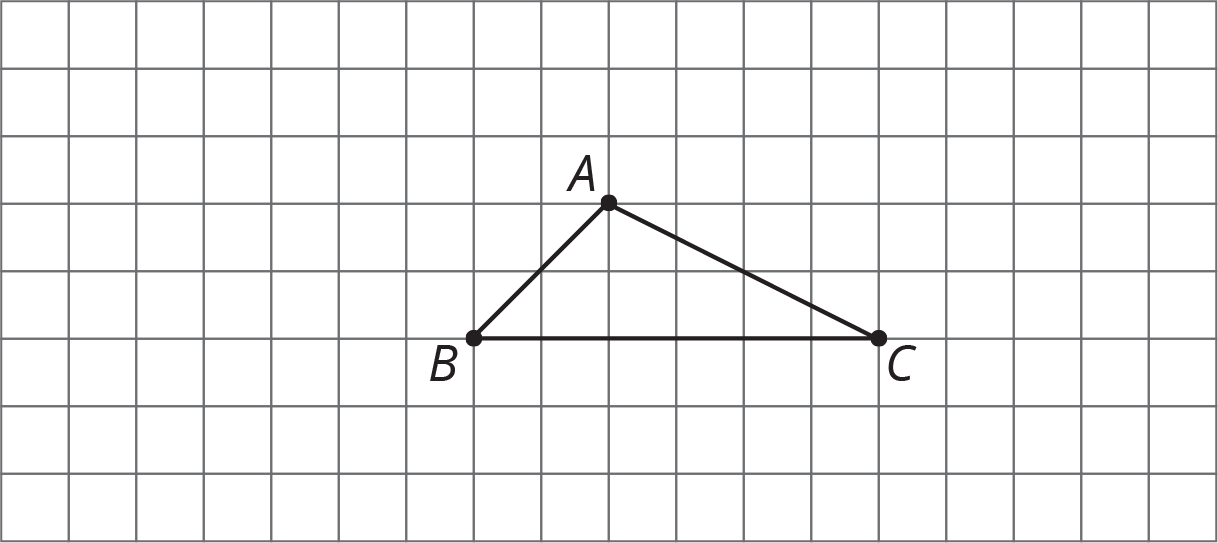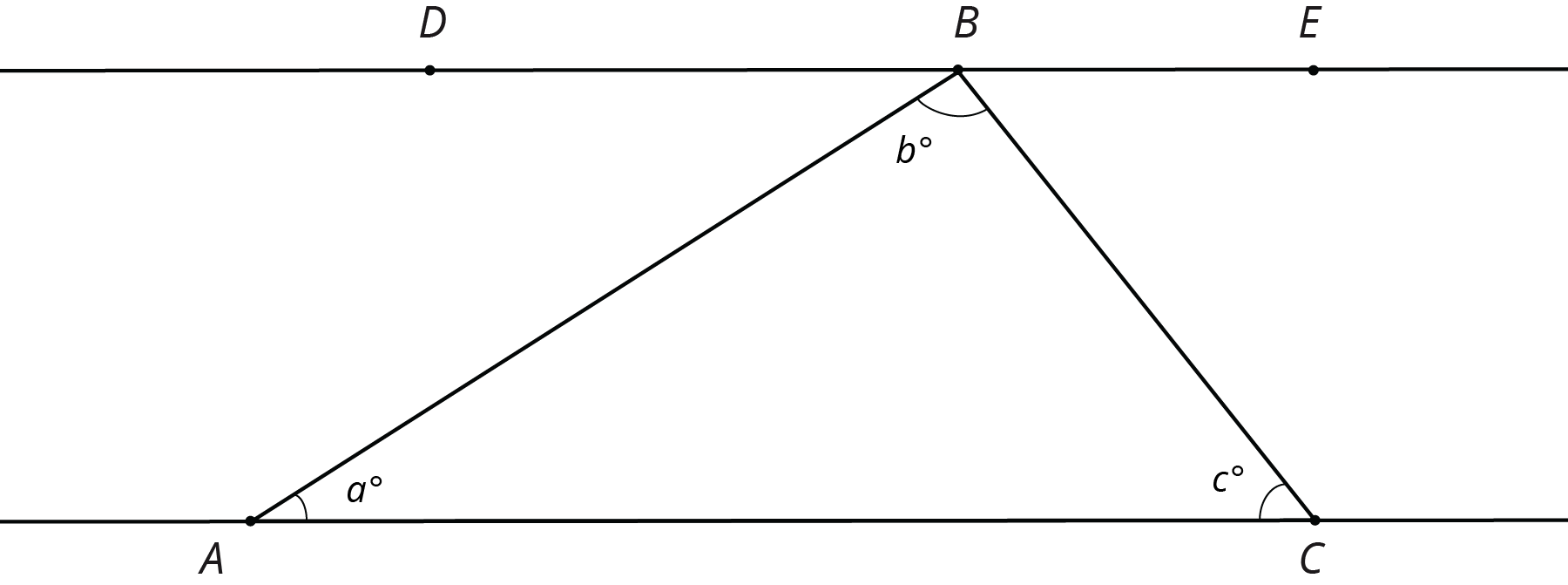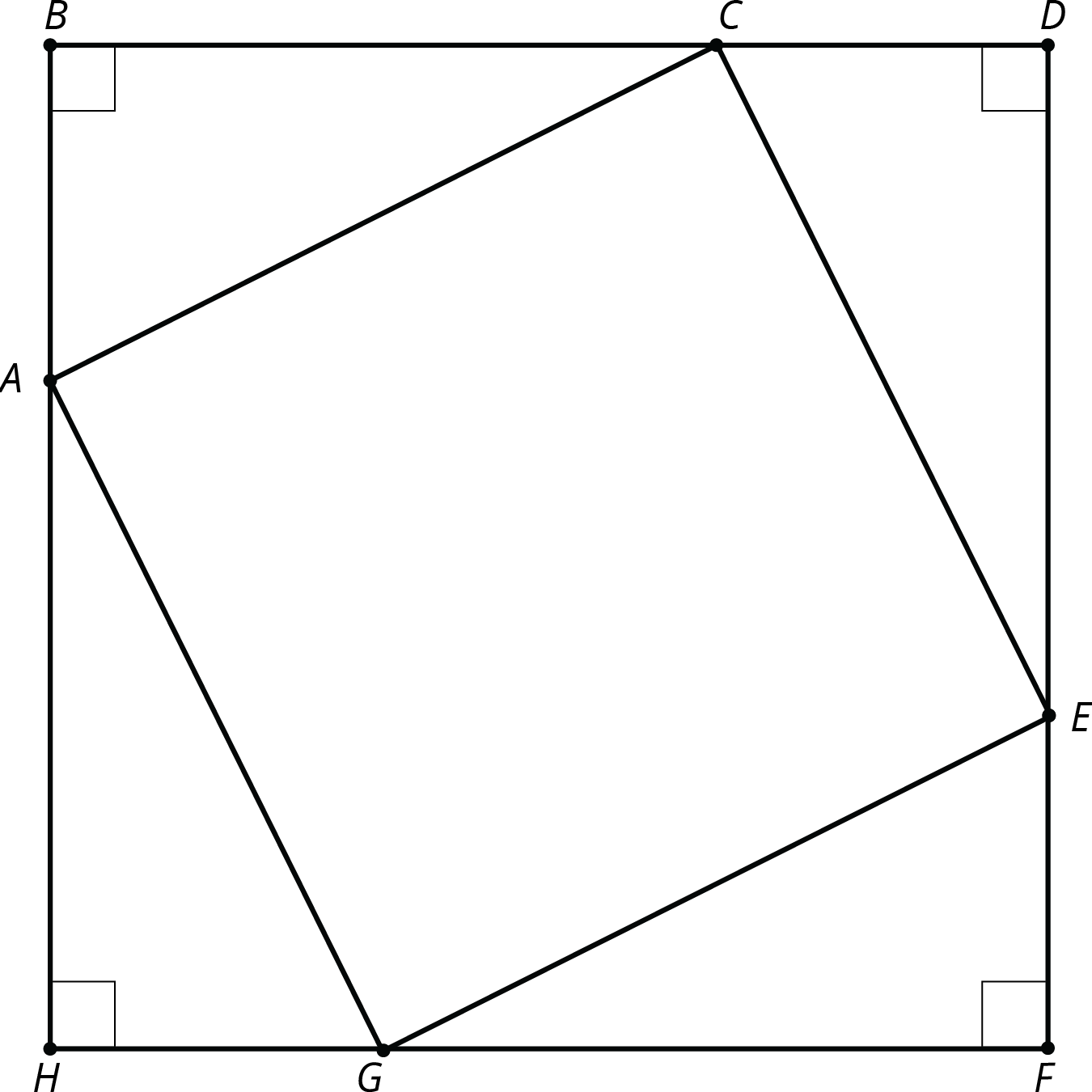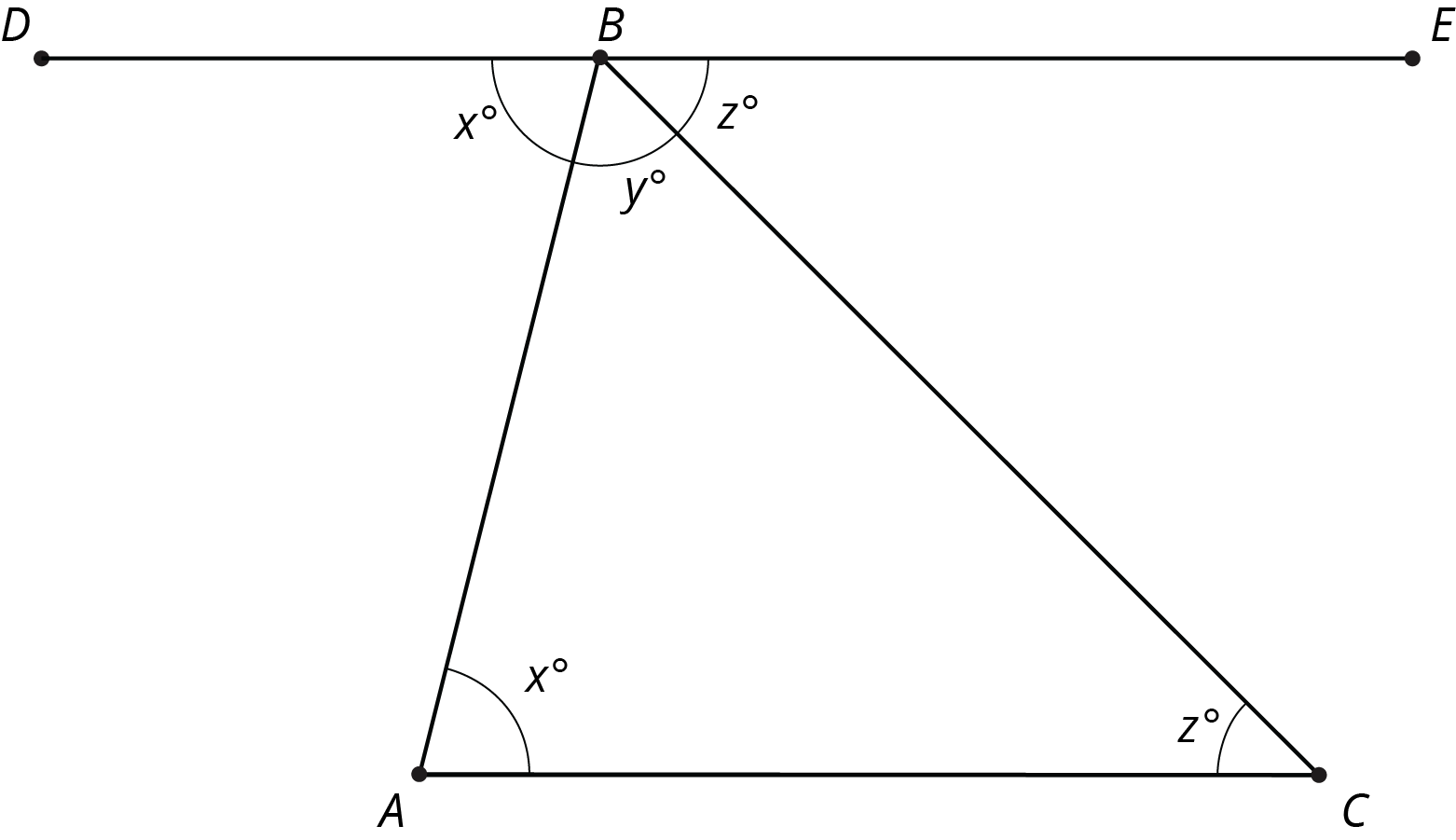Lesson 14
Parallel Lines and the Angles in a Triangle
14.1: True or False: Computational Relationships (5 minutes)
Warm-up
This warm-up encourages students to reason algebraically about various computational relationships and patterns. While students may evaluate each side of the equation to determine if it is true or false, encourage students to think about the properties of arithmetic operations in their reasoning.
Seeing the structure that makes the equations true or false develops MP7.
Launch
Display one problem at a time. Tell students to give a signal when they have an answer and a strategy. After each problem, give students 1 minute of quiet think time and follow with a whole-class discussion.
Student Facing
Is each equation true or false?
\(62-28= 60-30\)
\(3\boldcdot \text{-}8= (2\boldcdot \text{-}8) - 8\)
Student Response
For access, consult one of our IM Certified Partners.
Anticipated Misconceptions
In the first question, students may think you can round or adjust numbers in a subtraction problem in the same way as in addition problems. For example, when adding \(62+28\), taking 2 from the 62 and adding it to the 28 does not change the sum. However, using that same strategy when subtracting, the distance between the numbers on the number line changes and the difference does not remain the same.
Activity Synthesis
Ask students to share their strategies for each problem. Record and display their explanations for all to see. Ask students how they decided upon a strategy. To involve more students in the conversation, consider asking:
- Do you agree or disagree? Why?
- Who can restate ___’s reasoning in a different way?
- Does anyone want to add on to _____’s reasoning?
After each true equation, ask students if they could rely on the reasoning used on the given problem to think about or solve other problems that are similar in type. After each false equation, ask students how we could make the equation true.
14.2: Angle Plus Two (15 minutes)
Activity
In the previous lesson, students conjectured that the measures of the interior angles of a triangle add up to 180 degrees. The purpose of this activity is to explain this structure in some cases. Students apply \(180^\circ\) rotations to a triangle in order to calculate the sum of its three angles. They have applied these transformations earlier in the context of building shapes using rigid transformations. Here they exploit the structure of the coordinate grid to see in a particular case that the sum of the three angles in a triangle is 180 degrees. The next activity removes the grid lines and gives an argument that applies to all triangles.
Launch
Arrange students in groups of 2–3. Provide access to geometry toolkits. Give 5 minutes work time building the diagram and measuring angles. Then allow for a short whole-class check-in about angle measurement error, and then provide time for students to complete the task.
Important note for classes using the digital activity: The applet measures angles in the standard direction, counterclockwise. Students need to select points in order. For example, to measure angle \(ACB\) in this triangle, students would select the angle measure tool and then click on \(A\), then \(C\), and then \(B\). If they click on \(B\), then \(C\), and then \(A\), they get the reflex angle.

Supports accessibility for: Organization; Attention
Student Facing
Consider triangle \(ABC\). Select the Midpoint tool and click on two points or a segment to find the midpoint.

-
Rotate triangle \(ABC\) \(180^\circ\) around the midpoint of side \(AC\). Right click on the point and select Rename to label the new vertex \(D\).
-
Rotate triangle \(ABC\) \(180^\circ\) around the midpoint of side \(AB\). Right click on the point and select Rename to label the new vertex \(E\).
-
Look at angles \(EAB\), \(BAC\), and \(CAD\). Without measuring, write what you think is the sum of the measures of these angles. Explain or show your reasoning.
-
Is the measure of angle \(EAB\) equal to the measure of any angle in triangle \(ABC\)? If so, which one? If not, how do you know?
-
Is the measure of angle \(CAD\) equal to the measure of any angle in triangle \(ABC\)? If so, which one? If not, how do you know?
-
What is the sum of the measures of angles \(ABC\), \(BAC\), and \(ACB\)?
Student Response
For access, consult one of our IM Certified Partners.
Launch
Arrange students in groups of 2–3. Provide access to geometry toolkits. Give 5 minutes work time building the diagram and measuring angles. Then allow for a short whole-class check-in about angle measurement error, and then provide time for students to complete the task.
Important note for classes using the digital activity: The applet measures angles in the standard direction, counterclockwise. Students need to select points in order. For example, to measure angle \(ACB\) in this triangle, students would select the angle measure tool and then click on \(A\), then \(C\), and then \(B\). If they click on \(B\), then \(C\), and then \(A\), they get the reflex angle.

Supports accessibility for: Organization; Attention
Student Facing
Here is triangle \(ABC\).

-
Rotate triangle \(ABC\) \(180^\circ\) around the midpoint of side \(AC\). Label the new vertex \(D\).
-
Rotate triangle \(ABC\) \(180^\circ\) around the midpoint of side \(AB\). Label the new vertex \(E\).
-
Look at angles \(EAB\), \(BAC\), and \(CAD\). Without measuring, write what you think is the sum of the measures of these angles. Explain or show your reasoning.
-
Is the measure of angle \(EAB\) equal to the measure of any angle in triangle \(ABC\)? If so, which one? If not, how do you know?
-
Is the measure of angle \(CAD\) equal to the measure of any angle in triangle \(ABC\)? If so, which one? If not, how do you know?
-
What is the sum of the measures of angles \(ABC\), \(BAC\), and \(ACB\)?
Student Response
For access, consult one of our IM Certified Partners.
Anticipated Misconceptions
Some students may have trouble with the rotations. If they struggle, remind them of similar work they did in a previous lesson. Help them with the first rotation, and allow them to do the second rotation on their own.
Activity Synthesis
Ask students how the grid lines helped to show that the sum of the angles in this triangle is 180 degrees. Important ideas to bring out include:
- A 180 rotation of a line \(BC\) (with center the midpoint of \(AB\) or the midpoint of \(AC\)) is parallel to line \(BC\) and lays upon the horizontal grid line that point \(A\) is on.
- The grid lines are parallel so the rotated angles lie on the (same) grid line.
Consider asking students, "Is it always true that the sum of the angles in a triangle is \(180^\circ\)?" (Make sure students understand that the argument here does not apply to most triangles, since it relies heavily on the fact that \(BC\) lies on a grid line which means we know the images of \(BC\), \(AE\) and \(DA\), also lie on grid line that point \(A\) is on.)
It turns out that the key to showing the more general result lies in studying the rotations that were used to generate the three triangle picture. This investigation is the subject of the next activity.
Design Principle(s): Support sense-making
14.3: Every Triangle in the World (15 minutes)
Activity
The previous activity recalls the \(180^\circ\) rotations used to create an important diagram. This diagram shows that the sum of the angles in a triangle is \(180^\circ\) if the triangle happens to lie on a grid with a horizontal side. The purpose of this activity is to provide a complete argument, not depending on the grid, of why the sum of the three angles in a triangle is \(180^\circ\).
In this activity, rather than building a complex shape from a triangle and its rotations, students begin with a triangle and a line parallel to the base through the opposite vertex:

In this image, lines \(AC\) and \(DE\) are parallel. The advantage to this situation is that we know that points \(D\), \(B\), and \(E\) all lie on a line. In order to calculate angles \(DBA\) and \(EBC\), students can use either the rotation idea of the previous activity or congruence of alternate interior angles of parallel lines cut by a transversal. In either case, they need to analyze the given constraints and decide on a path to pursue to show the congruence of angles. Students then conclude from the fact that \(D\), \(B\), and \(E\) lie on the same line that \(a + b +c = 180\).
There is a subtle distinction in the logic between this lesson and the previous. The previous lesson suggests that the sum of the angles in a triangle is \(180^\circ\) using direct measurements of a triangle on a grid. This activity shows that this is the case by using a generic triangle and reasoning about parallel lines cut by a transversal. But, in order to do so, we needed to know to draw the line parallel to line \(AC\) through \(B\) and that this idea came through experimenting with rotating triangles.
Launch
Keep students in the same groups. Tell students they’ll be working on this activity without the geometry toolkit.
In case students have not seen this notation before, explain that \(m \angle DBA\) is shorthand for "the measure of angle \(DBA\)."
Begin with 5 minutes of quiet work time. Give groups time to compare their arguments, then have a whole-class discussion.
Supports accessibility for: Language; Organization
Design Principle(s): Cultivate conversation; Support sense-making
How It Happens:
- Ask students to keep their books or devices closed and display only the image and the task statement without revealing the questions that follow.
Ask, “What mathematical questions could you ask about this image?” - Give students 1 minute of individual time to write questions, and then 3 minutes to share ideas with a partner.
- Invite each pair of students to contribute one written question to a poster, the whiteboard, or digital projection. Call on 2–3 pairs of students to present their question to the whole class, and invite the class to make comparisons among the questions.
Listen for and amplify any questions involving the relationships between the sum of angles in a triangle and in a straight angle. - Reveal the three follow-up questions for this task and give students a couple of minutes to compare them to those on the display. Identify similarities and differences.
Consider providing these prompts: “Which of your questions is most alike or different to the ones provided? Why?”, or “Is there a main mathematical concept that is present in both your questions and those provided? If so, describe it.” - Invite students to choose one student generated question (from the display) before continuing on to the task.
Student Facing
Here is \(\triangle ABC\). Line \(DE\) is parallel to line \(AC\).

-
What is \(m{\angle DBA} + b + m{\angle CBE}\)? Explain how you know.
- Use your answer to explain why \(a + b + c = 180\).
-
Explain why your argument will work for any triangle: that is, explain why the sum of the angle measures in any triangle is \(180^\circ\).
Student Response
For access, consult one of our IM Certified Partners.
Student Facing
Are you ready for more?
-
Using a ruler, create a few quadrilaterals. Use a protractor to measure the four angles inside the quadrilateral. What is the sum of these four angle measures?
-
Come up with an explanation for why anything you notice must be true (hint: draw one diagonal in each quadrilateral).
Student Response
For access, consult one of our IM Certified Partners.
Anticipated Misconceptions
Some students may say that \(a, b,\) and \(c\) are the three angles in a triangle, so they add up to 180. Make sure that these students understand that the goal of this activity is to explain why this must be true. Encourage them to use their answer to the first question and think about what they know about different angles in the diagram.
For the last question students may not understand why their work in the previous question only shows \(a + b + c = 180\) for one particular triangle. Consider drawing a different triangle (without the parallel line to one of the bases), labeling the three angle measures \(a, b, c\), and asking the student why \(a + b + c = 180\) for this triangle.
Activity Synthesis
Ask students how this activity differs from the previous one, where \(\triangle ABC\) had a horizontal side lying on a grid line. Emphasize that:
- This argument applies to any triangle \(ABC\).
- The prior argument relies on having grid lines and having the base of the triangle lie on a grid line.
- This argument relies heavily on having the parallel line to \(AC\) through \(B\) drawn, something we can always add to a triangle.
The key inspiration in this activity is putting in the line \(DE\) through \(B\) parallel to \(AC\). Once this line is drawn, previous results about parallel lines cut by a transversal allow us to see why the sum of the angles in a triangle is \(180^\circ\). Tell students that the line \(DE\) is often called an ‘auxiliary construction’ because we are trying to show something about \(\triangle ABC\) and this line happens to be very helpful in achieving that goal. It often takes experience and creativity to hit upon the right auxiliary construction when trying to prove things in mathematics.
14.4: Four Triangles Revisited (5 minutes)
Optional activity
This activity revisits a picture that students have seen earlier and that they will see again later when they investigate the Pythagorean Theorem. The four right triangles around the boundary make a quadrilateral inside which happens to be a square. Since the four triangles surrounding the inner quadrilateral are congruent by construction, this makes the inner shape a rhombus. The angle calculations that students make here justify why it is actually a square. The fact that quadrilateral \(ACEG\) is a square is not asked for in the activity, but if any students notice this, encourage them to share their observations and reasoning.
Students are making use of structure (MP7) throughout this activity, most notably by:
- Using the fact that congruent triangles have congruent angles.
- Using the fact that the measures of angles that make a line add up to 180 degrees.
Launch
Provide 3 minutes of work time followed by a whole-class discussion.
Supports accessibility for: Memory; Language
Student Facing
This diagram shows a square \(BDFH\) that has been made by images of triangle \(ABC\) under rigid transformations.

Given that angle \(BAC\) measures 53 degrees, find as many other angle measures as you can.
Student Response
For access, consult one of our IM Certified Partners.
Activity Synthesis
Display the image of the 4 triangles for all to see. Invite students to share how they calculated one of the other unknown angles in the image, adding to the image until all the unknown angles are filled in.
In wrapping up, note that angles \(ACE\), \(CEG\), \(EGA\), and \(GAC\) are all right angles. It’s not necessary to show or tell students that \(ACEG\) is a square yet. This diagram will be used in establishing the Pythagorean Theorem later in the course, so it’s a good place to end.
Design Principle(s): Optimize output (for explanation); Support sense-making
Lesson Synthesis
Lesson Synthesis
Revisit the basic steps in the proof that shows that the sum of the angles in a triangle is \(180^\circ\). Consider asking a student to make a triangle that you can display for all to see and add onto it showing each step.
- We had a triangle, and a line through one vertex parallel to the opposite side.
- We knew that the three angles with their vertices on the line summed to \(180^\circ\).
- We knew that two of these angles were congruent to corresponding angles in the triangle, and the third one was inside the triangle.
- Therefore, the three angles in the triangle must also sum to \(180^\circ\).
Tell students that this is one of the most useful results in geometry and they will get to use it again and again in the future.
14.5: Cool-down - Angle Sizes (5 minutes)
Cool-Down
For access, consult one of our IM Certified Partners.
Student Lesson Summary
Student Facing
Using parallel lines and rotations, we can understand why the angles in a triangle always add to \(180^\circ\). Here is triangle \(ABC\). Line \(DE\) is parallel to \(AC\) and contains \(B\).

A 180 degree rotation of triangle \(ABC\) around the midpoint of \(AB\) interchanges angles \(A\) and \(DBA\) so they have the same measure: in the picture these angles are marked as \(x^\circ\). A 180 degree rotation of triangle \(ABC\) around the midpoint of \(BC\) interchanges angles \(C\) and \(CBE\) so they have the same measure: in the picture, these angles are marked as \(z^\circ\). Also, \(DBE\) is a straight line because 180 degree rotations take lines to parallel lines. So the three angles with vertex \(B\) make a line and they add up to \(180^\circ\) (\(x + y + z = 180\)). But \(x, y, z\) are the measures of the three angles in \(\triangle ABC\) so the sum of the angles in a triangle is always \(180^\circ\)!